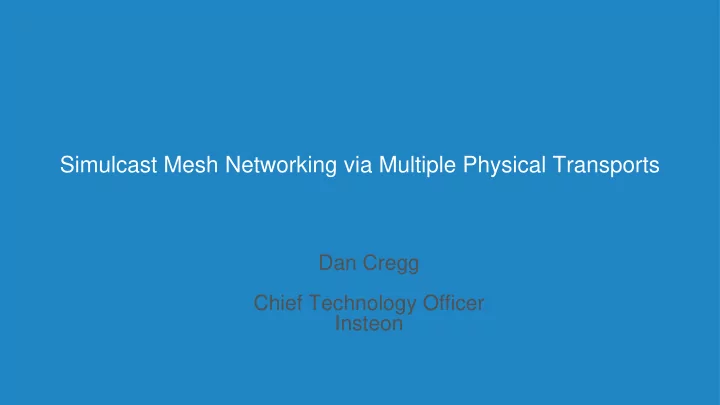

Simulcast Mesh Networking via Multiple Physical Transports Dan Cregg Chief Technology Officer Insteon
What is this talk about? 50 billion devices by 2020 Over 50 billion devices by 2020 Up to $6.2 trillion by 2025 $7.3 trillion by 2017 IoT Internet of Things Massive Opportunities +
But problems too – like scaling Network Practical Maximums • Bluetooth – 9 • WiFi – Dozen ? • Zwave / Zigbee - 35
…and more problems – range & reliability Consumers are much more sensitive to IoT failures than other consumer electronic glitches
…. and still many more problems Appearances Technologies • It Looks Easy • Don’t scale • Misperceptions • Don’t reach (Range) • Misinformation • Not Reliable • FUD • Ignorance of what matters • Everything will have IP address • Open standards demand • Megabytes of data needed • Lack of compatibility Products • Cool but useless • Single point of failure • We can make it better • Network overheads • Setup is too complex • Can tie it all together • Popcorn effect • Lack of a value proposition • Push Model • Healing • Too many Interconnect protocols • Funding driving uptake • Ad hoc setup • Too many single point solutions • Incorrect Conclusions • Too narrow product offerings • Too many setup paradigms • Too many styles / designs • Too many ecosystems • Too few international solutions
Simulcast Mesh Networking via Multiple Physical Means Designed specifically for the IoT Solves the problems
Simulcast Mesh Network? Multiple Physical Means? Distributed Intelligence?
Wireless Network Signal Propagation Examples Point to Point - Wifi (Wireless Local Area Network) very high data rate – e.g. Video, Practical node count in 10’s depending on usage Star – Bluetooth (Personal Area Network) high data rate – e.g. Audio, ~8 nodes per network Mesh, Routed – 802.15.4 (various) Relatively low data rate (utility meters), Practical node count in 10’s Mesh, Simulcast – Insteon (Wireless Device Area Network) Electronic Design, Lou Frenzel, Nov 29,2012 Relatively low data rate, very high node count
Mesh, Routed Transmitter T Original Message 1 st Hop Target Responder 2 nd Hop 3 rd Hop R R
Mesh, Simulcast T = Massive Scalability R R Insteon - 1 st Hop Insteon - Original Message
Simulcast – even the biggest homes With routed networks, different types of products require different commands clogging the network and causing delays – it just doesn’t scale Simulcast has no theoretical maximum network size and we’ve never heard of a practical one Dinnertime Scene – Using Routed Networks Unicast Unicast Unicast Broadcast Off Open Fully Heat 68 50% Bright with Simulcast Broadcast Dinnertime Homes will have hundreds of devices, commercial buildings even more Insteon is used in buildings over ½ millions square feet and even throughout large campuses
Multiple Physical Means • Typical today = 2.4GHz Radio Frequency, various methods • All share the same physical space • Limited to the constraints of RF propagation • Most significant impediments are physical structures (walls, appliances, people) • Using more than one physical method to propagate a signal significanly improves reliability
Dual mesh Transmitter Receiver Concrete, metal, etc. RF Wifi, Bluetooth, 802.15.4 RF Powerline Insteon With both RF and powerline a much greater range is achieved
Dual mesh – 100 x more reliable Insteon gets through, even if both physical paths are blocked Controller Mesh Repeaters Responder RF Powerline 3 rd 2 nd 1 st Original Hop Hop Transmission Hop Since RF and Powerline obstructions are rarely at the same place and time When used together error rates are only 1% of a single band network
Summary • Simulcast all devices help propagate signals providing massive scale • • Multiple Physical Means mitigates issues specific to any one single method • • Distributed Intelligence Instant reaction on a massive scale without function • compatibility issues
Range Reliability Scalability Compatibility 200 Products – 3,000 Retail Outlets – 100 Countries 16542 Millikan Avenue Irvine, CA 92606 – www.insteon.com
Recommend
More recommend